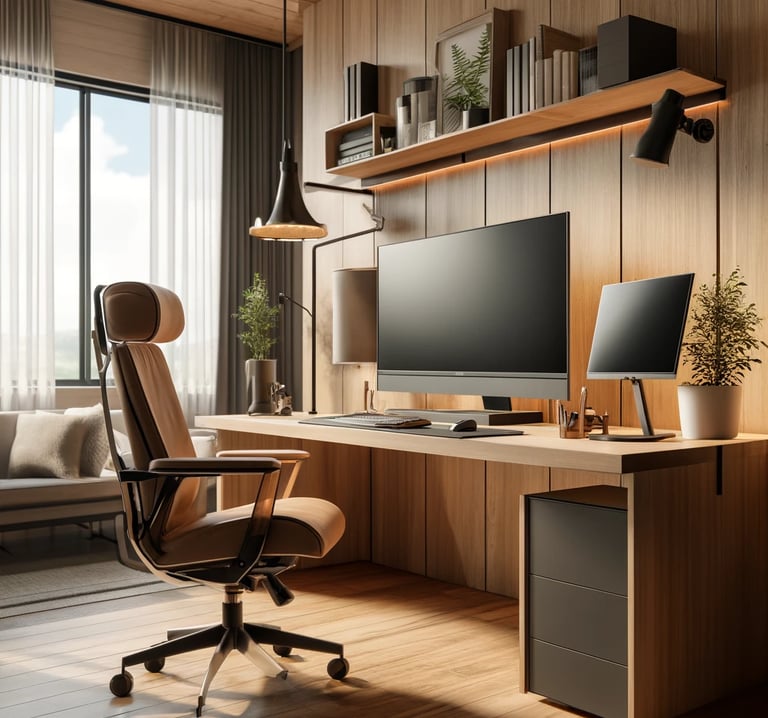Home Office Setup: Designing a Productivity-Boosting Workspace
With remote work becoming more common, having a well-designed home office is essential for productivity and comfort. A thoughtfully planned workspace can enhance focus, reduce stress, and create an environment where you feel motivated to work. Whether you’re setting up a new home office or looking to improve your current space, here are some key design tips to create an efficient and inspiring workspace.
Sakina Baxa
1/28/20252 min read


1. Choose the Right Location
The first step in designing a productive home office is selecting the right location. If you have a spare room, that’s ideal, but if not, consider a quiet corner in your bedroom or living area. Look for a space with minimal distractions and, if possible, natural light to improve mood and focus.
Tip:
• Avoid setting up your workspace in high-traffic areas to minimize interruptions.
2. Invest in Ergonomic Furniture
Comfort is key when working from home for long hours. Invest in a sturdy, ergonomic chair and a spacious desk that suits your needs. Poor posture can lead to back and neck strain, so choose a chair with proper lumbar support and adjustable height.
Tip:
• Keep your computer screen at eye level to prevent neck strain.
• Use a footrest if your feet don’t reach the ground comfortably.
3. Maximize Natural and Artificial Lighting
Good lighting is essential for reducing eye strain and boosting productivity. Ideally, position your desk near a window to take advantage of natural light. If that’s not possible, use a combination of ambient, task, and accent lighting.
Tip:
• Use a desk lamp with adjustable brightness to prevent glare on your screen.
• Warm lighting can create a cozy and inviting workspace.
4. Keep Your Desk Organized
A cluttered desk can be distracting and reduce efficiency. Invest in smart storage solutions like floating shelves, drawer organizers, and file holders to keep everything in place. A clean workspace fosters a clear mind and helps you stay focused.
Tip:
• Keep only essential items on your desk to maintain a minimalist and organized look.
5. Personalize Your Space
Your home office should be a space where you feel inspired and motivated. Adding personal touches like artwork, plants, or decorative items can make the space more inviting. However, be mindful not to overdo it—too much décor can be distracting.
Tip:
• Indoor plants like succulents or snake plants improve air quality and create a calming effect.
6. Manage Cables and Tech Setup
Messy cables can make your workspace look untidy and even create safety hazards. Use cable organizers, clips, or under-desk trays to keep wires neatly arranged. Ensure your home office has strong Wi-Fi, surge protectors, and necessary accessories like a good-quality webcam and noise-canceling headphones.
Tip:
• Label cables to easily identify which one belongs to which device.
7. Create a Distraction-Free Zone
Setting boundaries is crucial for maintaining focus. If possible, separate your work area from personal or leisure spaces. Use noise-canceling headphones or soft background music to block out distractions.
Tip:
• Communicate with family members about your work hours to minimize interruptions.
8. Incorporate Movement and Break Areas
Sitting for long hours can be unhealthy. Designate a small corner for stretching or short breaks. Consider using a standing desk or an ergonomic chair that allows movement throughout the day.
Tip:
• Follow the 20-20-20 rule: Every 20 minutes, look 20 feet away for 20 seconds to reduce eye strain.
9. Use a Whiteboard or Glass Board for Notes and Planning
Having a whiteboard or glass board on the wall in front of your workspace can be a game-changer for organization and productivity. It serves as a central space to jot down ideas, reminders, and to-do lists, keeping important tasks visible throughout the day.Final Thoughts
Tip:
• Choose a board with a magnetic surface to pin important documents or reference materials.
A well-designed home office enhances productivity, creativity, and overall well-being. By choosing the right location, investing in ergonomic furniture, optimizing lighting, and keeping your space organized, you can create a workspace that keeps you motivated and focused.


